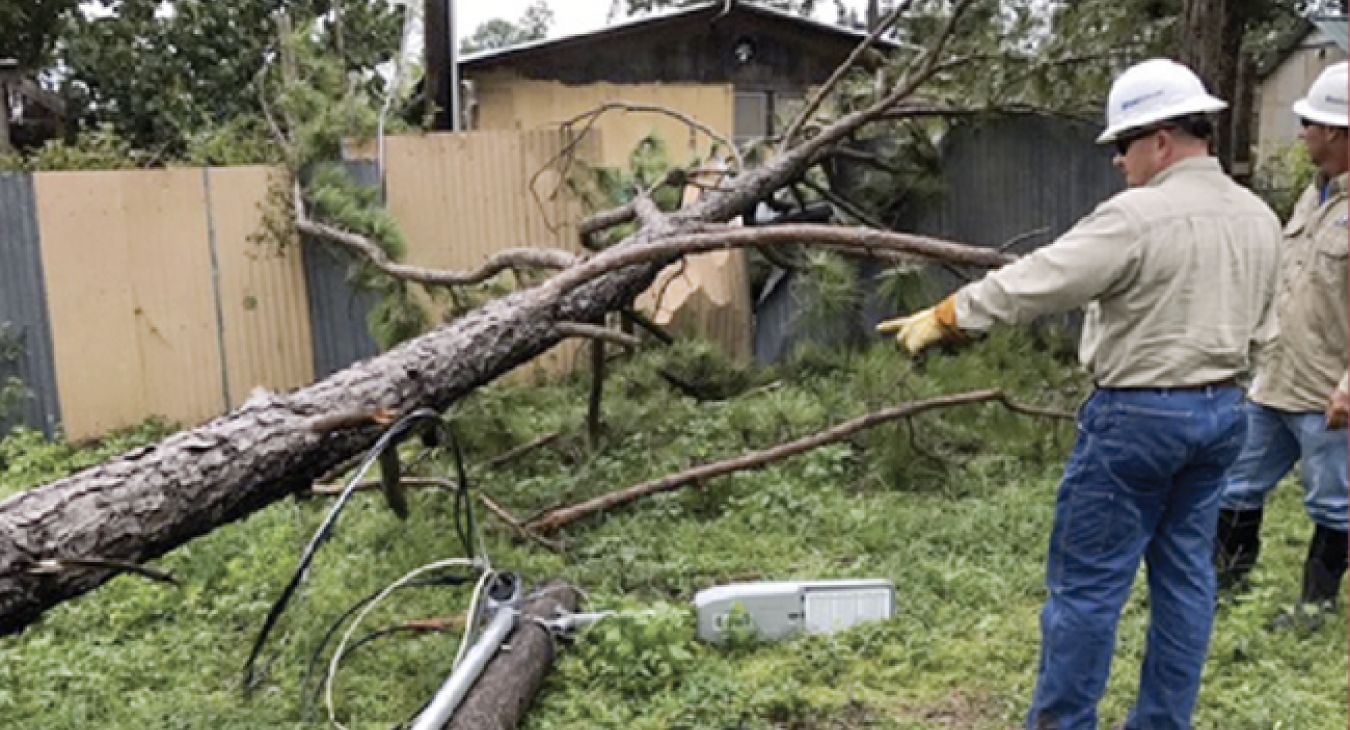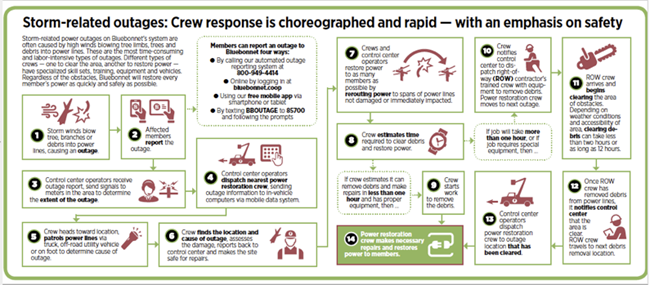Linemen John Matejcek and Tim Mittasch survey the damage caused by a tree blown down by Hurricane Harvey’s winds. The site was near Paige. (Dean Meinke photo)
The gusts of wind and rain began late on Friday, Aug. 25. Before it was over, Hurricane Harvey blasted Bluebonnet Electric Cooperative’s service area with destructive winds and drenching rains. Crews responded to 602 service calls, 396 of which were power outages that affected 12,760 members.
There was flooding throughout the co-op’s 3,800-square-mile service area, from Washington County to Hays County and everywhere in between. Cities along the Colorado River — Bastrop, Smithville, La Grange — saw the waters rise higher and higher, covering roads and seeping into homes and businesses. Days after the storms, collapsed roads and flood damage continued to take a toll on Central Texans. Several counties in the region have been declared disaster areas.
During the course of the storm, Bluebonnet had 50 co-op crews and just as many contractor crews working 12-hour shifts, around the clock, for more than three days. Many outages were caused by downed power poles and line.
Although the extent of the damage in Central Texas did not rival the devastation and loss of life Harvey brought to the Texas coast and Houston, it brought normal life to a standstill for thousands of our region’s residents. The storm’s impact will be felt for months in Bluebonnet’s service area.
The fact that no lives were lost in the Bluebonnet region during the hurricane is evidence that heeding warnings and taking safety measures pay off.
During the outages, Bluebonnet members had a lot of questions about the causes of their outages and what they should do during protracted periods without power. We’ve compiled the most frequently asked questions and our answers. Our infographic on pages 20-21 shows you how we restore power during a storm. We've also got some tips and lists, and we'll have more at bluebonnet.coop/outages.
Hopefully we’ll never see another storm like Harvey, but it’s good to be prepared.
Frequently asked questions about outages
When I report outages to
800-949-4414, what information should I include?
If you call from a phone number tied to your account and have information to share, such as a tree falling into power lines or that you heard a loud pop, please leave that in the message. If you call from a phone number that isn’t tied to the location of the outage, please leave a message with the full address, contact phone number, the name on the account and any other relevant information.
Do I have to report the outage to have my power restored? Or does Bluebonnet know my power is out even if I’m not home and am unaware of the outage?
Members should report every outage to ensure that it is included in the co-op’s outage management system. You may be part of a larger outage that has already been reported, but it’s always best to report your outage.
I called to report my outage, but I don’t see it on Bluebonnet’s online outage map. Does that mean I need to call back?
If you called from a phone number tied to your account, the outage will typically show up on the co-op’s outage viewer within a few minutes. It is important to make sure the contact information on your account is up to date. You can update your information by logging in to your online account at bluebonnet.coop or via our mobile app, or by calling member services at 800-842-7708 from 7 a.m. to 5:30 p.m. Monday through Friday.
I’ve called the automated
outage phone number to
report my outage. Can I also talk to a member service representative?
Bluebonnet’s outage line allows the co-op to receive many calls about outages simultaneously. It’s efficient and effective and enables us to serve more members quickly, rather than having individuals answer each phone call. If you leave a message requesting a return call, we will make every effort to contact you, although that can take time during large outage events.
Electricity is critical to the health of someone in my household (like someone who uses an oxygen machine). Should I let Bluebonnet know about this?
This is something important that should be documented with Bluebonnet well before any storms or outages occur. Please inform Bluebonnet as soon as possible about the health concern in your home. Call 800-842-7708 and speak to a member service representative. The representative will send you a critical care form to fill out and have signed by a physician. Unfortunately, no utility can guarantee constant service or immediate restoration, especially during widespread, weather-related power outages. Bluebonnet recommends having a plan in place to accommodate medical needs in the event of prolonged outages.
What caused my power to go out?
Weather is the top reason for power outages. In major weather events that cause widespread outages, high winds and heavy rain can uproot and fell large trees or blow their limbs into power lines. Equipment — from transformers to insulators and fuses — can be damaged. Sometimes power poles are knocked down or partially broken. Flooding typically prolongs outages because crews have limited access to the place where repairs are needed. Lightning often damages equipment, and sometimes that damage cannot be seen by a crew on the ground.
Can Bluebonnet tell me when my power will be back on?
It is difficult to estimate restoration times because each outage and every outage event is different. Repair work is affected by the cause of the outage, how much damage was done, weather conditions, number of outages and time of day. In the case of a major weather event, it’s even harder to estimate restoration times. Standard estimated restoration times are posted on Bluebonnet’s outage map viewer, which you can see at outage. bluebonnetelectric.coop:82 on our website or via our mobile app. The information is also available via the outage phone line, but exact restoration times vary.
Does Bluebonnet ever call with information about an outage caused by a storm, especially if there are many without power?
Frequently, the co-op sends out automated calls to members who will be out of power for an extended time. Sometimes, Bluebonnet member service representatives will call individual members who will be out of power for an extended time.
How else can I find out about outages during and after a storm?
The co-op tries its best to keep members informed through its website, bluebonnet.coop, as well as its online outage viewer, social media (Facebook and Twitter), automated calls and traditional media such as TV, radio and newspapers. In a major event, Bluebonnet may also keep members updated by extending the hours that member service representatives are available to answer calls.
My neighbor’s lights are on, but mine aren’t? Why is that happening?
Even though your properties are close, your home or business could be on a different section of power line, or your outage may be an isolated incident. The source of any outage may be miles from your location, not visible to you. You may see Bluebonnet trucks on roads near your house, even though your power is still out. That’s because we have different types of crews doing jobs. See the infographic on pages 20-21 for details.
I think I see a live power line on the ground. What should I do?
Call 911 and stay far away! Then call Bluebonnet’s outage line at 800-949-4414. A live line on the ground is extremely dangerous and can electrocute someone 25 feet away or farther. An energized line doesn’t always spark or arc, or do anything to indicate it is still electrified. Assume all downed power lines are electrified.
What else can I do to plan ahead for various weather events?
We have more tips, lists and advice on the Outages and Storms page on the co-op’s website at bluebonnet.coop/outages.
Flooding safety: Stay safe when the waters rise
Flooding is the most common type of natural disaster in the United States. Here are a few recommendations for planning:
- Know and follow all directions from local officials for community evacuation or seek high ground for localized flooding. Plan ahead by knowing your community’s local flood evacuation plan. Identify escape routes from your location if roads are flooded.
- Consider buying a NOAA Weather Radio All Hazards receiver, which receives broadcast alerts directly from the National Weather Service. You can purchase these at many retail locations or online. For more information on them, visit nws.noaa.gov/nwr.
- Avoid walking or driving through flood waters. Just 6 inches of moving water can knock you down, and 1 foot of water can sweep your vehicle away.
- If there is a chance of flash flooding, move immediately to higher ground. Flash floods are the No. 1 cause of weather-related deaths in the U.S., not just during Hurricane Harvey.
- If floodwaters rise around your car but the water is not moving, abandon the car and move to higher ground. Do not leave the car to enter moving water.
- Avoid camping or parking along streams, rivers and creeks during heavy rainfall. These areas can flood quickly and with little warning.
- Return home only when authorities say it is safe.
- Watch out for debris where floodwaters have receded.
- After the storm, avoid standing water because it might be contaminated.






